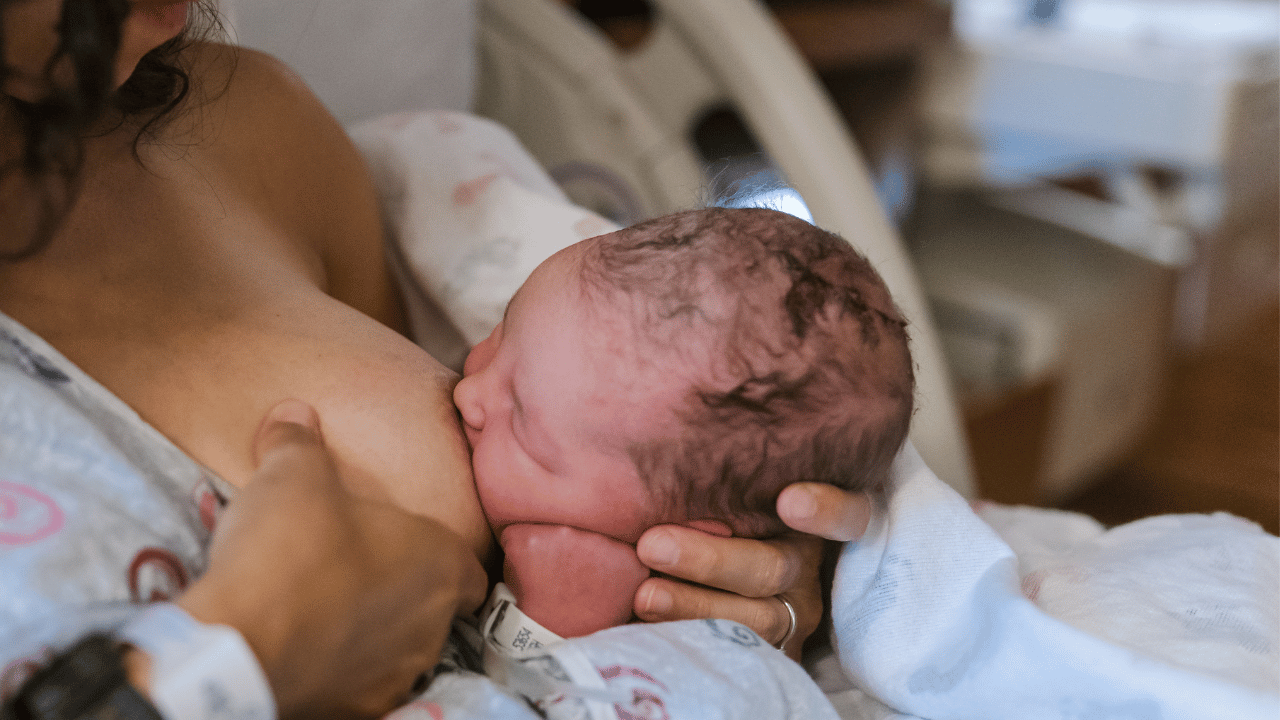Blood in Your Breast Milk? Here's What It Means and How to Handle It
Blood found in breast milk is usually not a serious issue; about 15% of all breastfeeding mothers have blood in their milk, most don't notice it. You may find blood inside your baby’s mouth after breastfeeding, in your baby's spit-up, or in your baby’s stools.

Blood In Breast Milk
Can You Continue to Breastfeed?
Finding blood in breast milk is nothing to worry about; it’s pretty common, especially for first-time breastfeeding mothers.
The blood cannot harm your baby; the blood consumed will pass through your baby's digestive tract as a bowel movement. Therefore, you can continue to breastfeed. Most blood in breast milk will go unnoticed unless a mother expresses.
As mentioned a little lower down on this page, some babies may reject milk with blood in it if the milk is left to stand for a while. If you are pumping, it's best to give the milk to your baby immediately after pumping, if possible.
Is the Blood From Your Baby or Your Breast?
If your baby has just puked up a large blood clot in their breast milk, you can keep it and take it to your doctor; they can check whether the blood is a baby's blood or an adult's.
The Color of Breast Milk
Blood in the breast milk can change the color of breast milk to shades of red, pink, orange, and even brown. But it's not always blood; certain foods can also change the color of your breast milk. Beetroot and things containing red coloring are well-known culprits. If this is the case, your milk should return to its original hue as soon as those foods have left your system. The food in a mother's diet can also change the color of her baby's stools.
Other foods that may change the color of your breast milk.

Tushbaby Hip Carrier
With its ergonomic design and comfortable waistband, Tushbaby provides optimal support for both you and your baby, allowing for bonding on the go. Say goodbye to shoulder and back pain from traditional carriers, as Tushbaby evenly distributes your baby's weight, relieving strain and promoting better posture.
What Causes Blood in Breast Milk?
The breastfeeding problems below usually end quickly and are not considered serious.
- Damaged or cracked nipples, blisters, cuts, and scrapes can cause a mother's nipples to bleed; this blood is often taken in by the infant during nursing. If the blood is due to cracked or damaged nipples, you should try to remedy the cause. Make sure that your baby is latching on well. (1) Look after your nipples. See how to look after your breasts while breastfeeding. Always check for signs of infection, such as swelling and pain. Learn more about identifying the cause of your cracked nipples.
- Vascular engorgement, AKA rusty pipe syndrome, can cause the milk to look rusty. Rusty Pipe Syndrome sometimes occurs during the first week after giving birth; it is more common in those mothers breastfeeding for the first time. During this time, there is much more blood flow while your breasts start to make milk; this blood may leak into your milk ducts. Your colostrum and milk will look brownish-orange, just like rusty pipe water, hence the name "rusty pipe syndrome." The blood in your breast milk will not harm your baby, so you can go ahead and breastfeed; it should clear within a few days.
- Broken capillaries due to breast injury. Rough treatment of your breasts, pressing your breast too hard while hand-expressing, and misusing a breast pump can cause breast trauma. Breast shells can also cause some internal capillary damage if used too often.
- A non-cancerous growth called an Intraductal Papilloma can cause bleeding from the nipples. These usually grow inside the milk duct and may cause a bloody breast milk discharge if they rupture the milk duct. This can sometimes cause quite a lot of blood to be swallowed by the baby, and if this is the case and the baby seems not to be handling the blood well, the mother will have to pump and dump her breast milk until she has stopped bleeding. Her baby will have to be supplemented during this time. These breast Papilloma tumors are typically only found in one breast and cannot be felt with the hand. Papilloma will usually subside naturally without any treatment.
- A breast infection can produce bloody milk from the affected breast. The symptoms of mastitis are discussed here.
- Fibrocystic changes in the breasts can cause some bleeding; this is normal and very common.
- Paget’s disease is a very rare form of breast cancer and occurs in only about 2% of all women who get breast cancer. The blood found in milk due to this is usually very persistent. Mom may also have red, itchy, scaly nipples and areolae. (Sometimes mistaken for thrush).
- Other breast cancers are unlikely causes, but if the bleeding does not stop within a week, you should contact your doctor to rule out ductal carcinoma.

Should I Dump Breast Milk With Blood?
A mother should continue to feed her baby. Blood in breast milk cannot harm a baby. If there is a lot of blood in the milk, it can cause the baby to vomit, but this is rare. If the baby does vomit, the mother can continue to breastfeed from the unaffected breast and pump and dump the milk from the other breast for a few days until there is no more blood in the milk.
The best thing to do is to wait it out. Time will give your breasts and nipples a chance to heal, and you can continue breastfeeding. Make sure you pump at least 8 - 10 times daily to keep your breast milk supply sufficient. If the bleeding continues past two weeks, it's best to contact your physician or lactation consultant.
When using a breast pump, ensure that the flange fits your breast comfortably and that the pump suction setting is not too high.
Be sure to contact a lactation consultant who can assess the situation and advise accordingly. Alternatively, opt for a Milkology breastfeeding course and equip yourself with the comprehensive knowledge necessary for a successful breastfeeding experience. It would be a good idea to check your baby's latch. A bad latch can cause cracked and bleeding nipples.
While Your Nipples Heal
- Take a breastfeeding-friendly pain reliever.
- Apply a cool compress to your breast after breastfeeding; this will help to soothe the pain.
- Breastfeed your baby when they show early signs of hunger, don't wait until they are ravenous.

How Blood in Breastmilk May Affect Your Baby
Most times, there will be no visible effects, but some babies may:
- Refuse the breast. The blood in your breast milk may change the taste of your milk. Some mothers have noticed that their babies are less likely to reject the blood-tinged milk if they drink directly from the breast, but milk stored in the fridge or freezer is often refused, probably due to a stronger taste.
- Start vomiting or spitting up more than usual. Excessive amounts of blood may cause vomiting.
- Have bloody stools, bloody streaks in their stools, or have darker than usual stools. Finding blood in your baby's diaper is not a reason for concern if you know that the blood came from your nipples. Instead, you may notice a few black streaks in the stool.
What If Your Baby Is Drinking Too Much Blood?
- If your baby seems to have a lot of bloody diarrhea, it is best to get to your doctor.
- If your baby’s jaundice is worsening, it is best to pump and dump until the bleeding stops.
- You should talk to your doctor before breastfeeding if you have any infections that can be transmitted via your blood.
